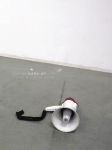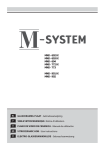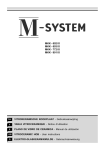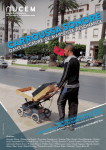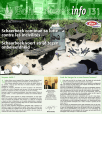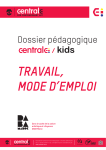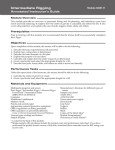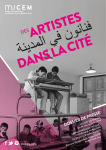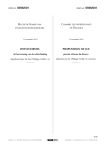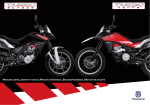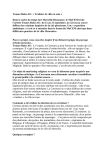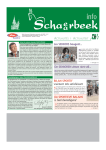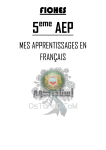Download b r u s s e l s b a c k g r o u n d b y y o u n e s b a b a - a l i
Transcript
brussels background by younes baba-ali eng. Younes Baba-Ali makes art that is unconventional, intelligent and critical, mostly in public space or places uncommon to art practice. He is a sharp observer and raises pertinent questions aimed at society, the institution and above all, his audience. As a free thinker he holds a mirror up to society and confronts it with its ingrained habits and dysfunctions. Baba-Ali’s work often assumes the form of the readymade, but underneath its facade of simplicity there is a complex exercise in balance at work. As an artist-alchemist he measures and mixes technology, objects, sound, video and photography with political, social and ecological issues. The resulting installations discreetly coerce the unsuspecting viewer into taking a stand. Baba-Ali shuns no controversy and often finds himself negotiating his art and its rationale with his environment. His works are context-specific and take their final form in dialogue with its spectators. This at times disruptive intervention art confronts the viewer in an ironical way with himself and his environment. Baba-Ali presents people dilemmas and taboos and challenges them to (re)act. In this way he makes them his accomplices in acts of artistic guerrilla that unite the establishment and the common man. Born in 1986 in Oujda (Ma), Younes Baba-Ali lives and works in Brussels (Be) & Casablanca (Ma). Graduating from l’Ecole Supérieure des Arts Décoratifs de Strasbourg in 2008, and from l’Ecole Supérieure d’Art d’Aix-en-Provence in 2011, he was rewarded by the prize “Léopold Sédar Senghor”, during the African Contemporary Art Biennial of Dakar (Sn) in 2012 and the prize “Boghossian”, during the Belgian Art Prize “Art’Contest” in Brussels (Be) in 2014. He has participated in several international exhibitions and biennials among them “Digital Africa: The Future is Now“, Southbank Centre, London (UK); “Strange Paradoxe”, MuCEM, Marseille (Fr); “Nass Belgica”, Botanique, Brussels (Be); “Where are we now?”, 5th Marrakech Biennial, Marrakech (Ma); “L’MAR9A”, Voice Gallery, Marrakech (Ma); “Travail, mode d’emploi”, Centrale for Contemporary Art, Brussels (Be); “Transaction Complete”, FaMa Gallery, Verona (It); “Dak’Art”, 10th African Contemporary Art Biennial, Dakar (Sn); “Regionale 12”, Haus für elektronische Künste, Basel (Ch); “Taverna Especial”, Sketch Gallery, London (Uk); “Brick & Mortar International Video Art Festival”, Greenfield (USA); “Loop” Video Art Festival, Barcelona (Es); “No Signal Found”, Arte Contemporanea Gallery, Brussels (Be); “Flowers, Animals, Urbans, Machines”, Appartement 22, Rabat (Ma) and “Desencuentros”, Sabrina Amrani Art Gallery, Madrid (Es). Cover : Zinneke (detail), 2014 Exhibition view “Brussels Background” - MAAC, Brussels (Be) - © Léa Catache Belooussovitch brussels background by hicham khalidi The artist Younes Baba-Ali was born in Morocco and grew up in France and lives for three years in Brussels; long enough to feed its own perception of the city while still maintaining a fresh perspective. Although he has a strong bond with his native country, Brussels became his hometown, a city that intrigues with its dynamism and which he observes with passion. Baba-Ali is a trans disciplinary artist who moves between different cities and cultures, building bridges where he feels it necessary. He is an observer who dares point sensitive topics and respond often offering situational dislocations. He does not seek to provide immediate solutions but to share with the public perceptions and feelings. For this solo exhibition at the MAAC, Brussels Background, he designed works mainly addressing the multicultural character of the city. Beyond that image promoted abroad as the cradle of Europe and as international crossroad, the artist questions critically the meeting of the different communities and their ways of daily life in this capital as well as the very concept integration. So, with five new designs and various forms of intervention, he further explores the fragmented side of Brussels relating to particular contexts. Baba-Ali starts from his origins, his personal relationship with the Moroccan diaspora to be open to reflections that go well beyond the specifics of this community. He raises the question: how do we live the multiculturalism and its implications? The work Multiculturalism / Multicommunitarism presents in the window of the MAAC a LED illuminated sign that alternates these two words, with a rhythm and an aspect marking a dysfunction. In this intervention, the artist re-uses a common object of the urban landscape, the panels of neighborhood stores (call shops, night shops, butchers, etc.). He also incorporates the advertising function of this object to lift, by challenging the passer-by, questions about the consequences of a multicultural society. Everyone is called Mohamed is an interactive sound creation aired in public space and composed of a speaker hanging on the outside of the MAAC. The artist calls directly to each of Brussels (inhabitant and / or visitor) who identifies himself with Mohamed, as the name designated in the Maghreb culture to challenge any male person whose identity is not known. Declined to the local context, Baba-Ali starts also on the observation that the first name Mohamed is one of the most frequently given in Brussels. Here he shows his desire to invite and interact with a lambda public. Hands-free kit is a series of photographic portraits of Moroccan women incorporating their mobile phones between the ear and the scarf. A gesture both common and ingenious in which religion, fashion, function and need meet. To be and not to have is a video in which a Belgian resident explains the different possibilities of access and strategies linked to local social welfare. This work refers to the flaws of a social system and the ratio of profit it can generate, as well as the phenomenon of a new form of immigration familiarly called “social tourism”. The title of this project refers to how these individuals advertise to society as people in need. The installation Zinneke consists of nests of parakeets recreated and integrated into the rear space of the MAAC with audio recordings of their calls in the city. These exotic birds fairly present in parks and green spaces in Brussels, are a domesticated species and released initially by the Heysel Zoo in 1974, as well as by individuals. Due to the global climate crisis, they thrive in the “new” climate of Brussels. Thus, the Zinneke installation is a metaphor for migration experienced by the city, the relationship between migrants and their new environment and their relationship with the local population. Through these works punctuating the exhibition Brussels Background Younes Baba-Ali explores some of the transformations resulting from local migration flows. He raises questions about the definitions of migration and multiculturalism, on the impacts generated by the encounter between different cultures in society. In this proposal, it is not to find solutions but rather to browse aesthetics consequences from the artists experience of the cultural and social results. Hicham Khalidi Brussels, 15th of November 2014 Hicham Khalidi is a Dutch-Moroccan curator of contemporary art. Khalidi is head of exhibitions and Artefact Festival at Stuk Art Centre in Leuven, Belgium. His latest exhibitions as a curator include: Where are we now? (main curator of the fifth Marrakech Biennale 2014); On Geometry and Speculation (as part of the 4th edition of the Marrakech Biennale, Marrakech, Morocco, 2012); Transnatural Festival (Nemo Science Center, Amsterdam, the Netherlands, 2012) and Alles, was Sie über Chemie wissen müssen (Künstlerhaus Bethanien, Berlin, Germany, 2011). younes baba-ali - art on the edge by kathleen weyts “My art finds its rationale in the society it emerges from. That’s its ground and its subject. I function as a mediator, as a philosopher who shares a form of awareness with others. I measure the temperature of society and contribute to its interpretation and development.” Visual artist Younes Baba-Ali summarizes his artistic démarche in a nice way. He makes art that is unconventional, intelligent and critical, often in public space or places uncommon to art practice. He is a sharp observer and raises pertinent questions aimed at society, the institution and above all, his audience. As a free thinker he holds a mirror up to society and confronts it with its ingrained habits and dysfunctions. His art originates rarely in the atelier. It is context-specific and takes its final shape in dialogue with its spectators. Context Some of Baba-Ali’s works function almost exclusively in a specific environment. Moroccan Anthem for example, a video in which a donkey driver clucks out the Moroccan national anthem using the sound he normally makes to command his animal. Other installations get their meaning in relation to the place where they are shown. Like Ending your life under the sun, a coffin with a tanning bed inside it. The idea for this work emerged during his stay on the Erasmus exchange program in Poland, where people frequently visit tanning salons. Presenting the work at the 4th Marrakesh Biennial – where visitors were primarily Western – the installation was perceived as dealing with North-South migration; when it was exhibited in Europe however, the interpretation shifted more toward “the idea of eternal beauty.” Art as intervention Ambiguity and humor are recurring elements in the work of this young artist. “I don’t want people to stay indifferent. I want to confront them and at the same time I want them to participate. I want to dispose art of its elitist and sacral status and to accomplish that I use certain strategies.” As an artist-alchemist he measures and mixes technology, objects, sound, video and photography with political, social and cultural issues. The resulting installations discreetly coerce the unsuspecting viewer into taking a stand. His work is constantly on the verge: it’s provocative, but never insulting or cheap, always inviting. It is the starting point for a conversation, a polemic, a thinking process, a (re) action. In a subtle way the artist plays the conventional social codes and at the same time the codes of art itself. Baba-Ali’s work often assumes the form of the readymade. He uses common objects and phenomena and introduces them in an artistic environment. But he prefers the public space to spaces intended for art. Making art accessible is almost a given in his oeuvre. In reaction to the extreme theorizing of art – where the audience is as it were assessed on its insider knowledge – and to the art institute that in the way it presents the artwork raises obstacles rather than remove them, he ingeniously intervenes in everyday life with his work. Carroussa Sonore is a beautiful example of this. A caroussa is a stroller with a sound system built on top, used for selling CD’s with Quranic recitals. A very common view in urban Maghreb streets, this object is a simple but extremely intelligent piece of technology. Baba-Ali uses it for his own purposes: “With Caroussa Sonore I bring sound pieces to people in a democratic way. It is both a creation and a medium I use as an art curator, since I invited other international artists to distribute their pieces via this module. It circles in the city, we built several interventions around it. In this way it becomes part of public life.” This intervention also denounces pertinent fallacies that circulate in the art world, such as the conviction that the Moroccan – and in extension Maghrebi – art scene limits itself to marketable objects. Baba-Ali proves the opposite by creating a platform for artists that are definitely active, but have difficulty in accessing the established European art scene - not in the least due to strict visa regulations. But as Baba-Ali puts it: “sound doesn’t need a visa, only a medium”. And rather than presenting his work to the establishment, he brings it to the people. This attitude is an implicit critique of both the art world and it’s critics. Baba-Ali addresses not just the art loving elite, but the people in the street. With this attitude he shows great affinity with artists such as Hassan Darsi and Francis Alÿs. Like them he makes disruptive intervention art that confronts the viewer – whether or not ironically – with himself and his environment. Baba-Ali presents people dilemmas and taboos and challenges them to (re)act. In this way he makes them his accomplices in a disguised artistic guerrilla that unites the establishment and the common man. Brussels Younes Baba-Ali was born in Oudja, Morocco but grew up and studied in France. Since 2011 he lives and works in Brussels. This double cultural background marks his life, his points of view and obviously his art. His affinity with both European and Maghrebi culture grants him the freedom to critically assess both worlds and to process this in his art practice. “As an artist I can afford to be critical. It’s my nature above all. Critique is a language that I learned to use. I raise questions and I want to involve the public. When observing Belgian society I notice that Moroccan immigration in France presents itself differently from that in Belgium. France is Morocco’s ‘big brother’, the ideal that Moroccan society and its elite try to attain. I observe the consequences of these phenomena and translate my findings into critical interventions.” An example of this is the installation Untitled (Speedbump) that he made for a group exhibition organised in a luxurious villa in the diplomatic district of Rabat. In that area – as in comparable wealthy areas in Morocco – huge speed bumps are installed. “To me this manipulation of urban space is very bourgeois and on top of that it’s immediately related to power. People in these quarters permit themselves to plump down speed bumps that are totally out of proportion. And so I decided to introduce these objects in their own living space, the bourgeois villa.” Baba-Ali does this fully aware that the audience that will visit the exhibition are the same people responsible for this phenomenon. By confronting them with it in the form of a work of art he also lends it a social dimension: “My interventions are to me also social, even political interventions that are coloured by their local context.” fr. In the exhibition he developed for MAAC, Baba-Ali takes his personal relation to Brussels as a starting point. He confesses he has a love-hate relationship with this city, which he perceives as very complex. Brussels proves to be an ideal laboratory for the artist to develop his oeuvre. He presents works that are on the one hand representative of how he experiences the city as a French-Moroccan immigrant, and on the other provide an insight in how the artist experiences living with the many residing nationalities there. “Brussels is a city that is distinctly multicultural – ranging from the European community to all the other immigrated nationalities – and at the same time marked by community issues.” Baba-Ali is constantly surprised by the resulting linguistic melting pot en the ongoing intercultural ‘negotiation’ that so clearly marks the Brussels public space. Since he came to Brussels he has been living in Molenbeek, a district he calls a ‘border zone’. The invisible but very distinct borders in Brussels and the way they divide the communities, are shocking to the artist. This observation leads to an artistic mental process: “my work originates in my head, not in my studio.” That process eventually comes into shape in the interaction with the audience. “I hope that people feel concerned with what I do. Positively or negatively – as long as it gets to them. I need the audience. Without it my work doesn’t function.” Younes Baba-Ali pratique un art non-conventionnel, intelligent et critique. Il travaille de préférence dans l’espace public ou dans des lieux peu communs. Fin observateur, il pose des questions pertinentes à la société, à l’institution, mais aussi surtout à son public. C’est un libre penseur, qui tend à la société un miroir et lui renvoie ses réflexes conditionnés et ses dysfonctionnements. L’œuvre de Baba-Ali se présente souvent sous la forme de ready-made, mais cette apparente simplicité dissimule un délicat exercice d’équilibre. À la manière d’un alchimiste, l’artiste dose et combine les techniques, les objets du quotidien, les sons, la vidéo et la photographie et adresse des questions politiques, sociales et écologiques. Les installations qu’il en distille poussent le spectateur à prendre position malgré lui. Baba-Ali ne recule pas devant la controverse et est même souvent contraint à de subtiles négociations avec son environnement pour revendiquer sa pratique artistique et son droit à l’existence. Son art est toujours spécifique à un contexte et ne prend vraiment sa forme que dans le dialogue du public. C’est de l’art d’intervention dérangeant et qui adopte parfois un ton ironique pour confronter le public à lui-même et à son environnement. Baba-Ali soumet au spectateur des dilemmes et des tabous et le défie d’agir et de réagir. Il en fait ainsi son complice dans une guérilla artistique clandestine qui réunit l’establishment et l’homme commun. Né en 1986 à Oujda (Ma), Younes Baba-Ali vit et travaille à Bruxelles (Be) et Casablanca (Ma). Kathleen Weyts, was for ten years the Head of Communications and Mediation in M HKA, Museum for Contemporary Art Antwerp. In this position she worked with several international acclaimed artists and art institutions. In 2013 she started PANACHE, an independent agency for visual artists, specializing in strategic advice, communication tactics and art management. She was responsible for the international PR of the 5th Moscow Biennial, curated the exhibition Trenches in Africa 1914-1918 and contributed to several art publications. She is board member of SIC, a workspace for professional audiovisual artists, Theater aan Zee, the annual theatre festival in Ostend and The University for the Common Good. Diplômé de l’Ecole Supérieure des Arts Décoratifs de Strasbourg en 2008, et de l’Ecole Supérieure d’Art d’Aix-en-Provence en 2011, il a été récompensé par le prix “Léopold Sédar Senghor”, lors de la Biennale d’Art Contemporain Africain de Dakar (Sn) en 2012 et du prix “Boghossian”, lors du Concours d’Art Belge “Art’Contest” à Bruxelles (Be) en 2014. Il a participé à plusieurs expositions internationales et biennales, parmi lesquelles “Digital Africa: The Future is Now“, Southbank Centre, Londres (UK); “Strange Paradoxe”, MuCEM, Marseille (Fr); “Nass Belgica”, Botanique, Bruxelles (Be); “Where are we now?”, 5ème Biennale de Marrakech, Marrakech (Ma); “L’MAR9A”, Voice Gallery, Marrakech (Ma); “Travail, mode d’emploi”, Centrale for Contemporary Art, Bruxelles (Be); “Transaction Complete”, FaMa Gallery, Verone (It); “Dak’Art”, 10ème Biennale d’Art Contemporain Africain, Dakar (Sn); “Regionale 12”, Haus für elektronische Künste, Bâle (Ch); “Taverna Especial”, Sketch Gallery, Londres (Uk); “Brick & Mortar International Video Art Festival”, Greenfield (USA); “Loop” Festival d’Art Vidéo, Barcelone (Es); “No Signal Found”, Arte Contemporanea Gallery, Bruxelles (Be); “Flowers, Animals, Urbans, Machines”, Appartement 22, Rabat (Ma) and “Desencuentros”, Sabrina Amrani Art Gallery, Madrid (Es). brussels background par hicham khalidi L’artiste Younes Baba-Ali est né au Maroc, il a grandi en France et vit depuis 3 ans à Bruxelles; assez longtemps pour nourrir sa propre perception de la ville tout en maintenant encore un regard neuf. Bien qu’il ait un lien fort avec son pays natal, Bruxelles représente pour lui sa ville de résidence, une ville qui l’intrigue par son dynamisme et qu’il observe avec passion. Baba-Ali est un artiste transdisciplinaire qui navigue entre différentes villes et cultures, jetant des ponts là où il le sent nécessaire. Il est un observateur qui ose pointer des sujets délicats et intervenir en proposant souvent des dislocations situationnelles. Il ne cherche pas à donner des solutions immédiates mais à partager avec le public ses perceptions et ses sentiments. Pour cette exposition personnelle à la MAAC, Brussels Background, il a conçu des oeuvres qui abordent principalement le caractère multiculturel de la ville. Au-delà de cette image promue à l’étranger, comme berceau de l’Europe et carrefour international, l’artiste interroge de façon critique la rencontre des différentes communautés et de leurs modes de vie quotidiens dans cette capitale ainsi que le concept même d’intégration. Ainsi, avec cinq nouvelles créations et sous différentes formes d’interventions, il explore davantage le côté fragmenté de Bruxelles en se rapportant à des contextes particuliers. Baba-Ali part de ses origines, de sa relation personnelle avec la diaspora marocaine, pour s’ouvrir à des réflexions qui vont bien au-delà des spécificités de cette communauté. Il nous pose la question: comment vivons-nous le multi-culturalisme et ses implications? L’oeuvre Multiculturalism / Multicommunitarism présente dans la vitrine de la MAAC une enseigne lumineuse led qui alterne ces deux mots, avec un rythme et un aspect marquant un certain dysfonctionnement. Dans cette intervention, l’artiste ré-exploite un objet commun du paysage urbain, celui des panneaux de magasins de quartier (téléboutiques, night shops, boucheries, etc). Il reprend aussi la fonction publicitaire de cet objet pour soulever, en interpellant le passant, des questions sur les conséquences d’une société multiculturelle. Tout le monde s’appelle Mohamed est une création sonore interactive diffusée dans l’espace public et composée d’un haut-parleur accroché à l’extérieur de la MAAC. L’artiste fait appel directement à chaque Bruxellois et / ou visiteur qui se reconnaît en Mohamed, prénom désigné dans la culture maghrébine pour interpeller tout individu masculin dont on ne connaît pas l’identité. Décliné au contexte local, Baba-Ali part aussi du constat selon lequel le prénom Mohamed est l’un des plus fréquemment donné à Bruxelles. Il montre ici son envie d’inviter et interagir avec un public lambda. Kit mains libres est une série de portraits photographiques de femmes marocaines incorporant leurs téléphones portables entre l’oreille et le foulard. Un geste à la fois commun et ingénieux dans lequel la religion, la mode, la fonction et la nécessité se rencontrent. Être et ne pas avoir est une vidéo dans laquelle un habitant belge explique les différentes possibilités d’accès et stratégies liées aux aides sociales locales. Ce travail renvoie aux failles d’un système social et au rapport de profit que cela peut engendrer, ainsi qu’au phénomène d’une nouvelle forme d’immigration appelée familièrement “tourisme social”. Le titre de ce projet fait référence à la façon dont ces individus s’annoncent à la société comme des personnes dans le besoin. L’installation Zinneke est composée de nids de perruches recréés et intégrés dans l’espace arrière de la MAAC avec des enregistrements sonores de leurs cris dans la ville. Ces oiseaux exotiques assez présents dans les parcs et espaces verts de Bruxelles, sont une espèce domestiquée puis libérée dans un premier temps par le zoo du Heizel en 1974, ainsi que par des particuliers. A cause de la crise climatique mondiale, ils prospèrent dans le “nouveau” climat de Bruxelles. Ainsi, l’installation Zinneke est une métaphore sur les flux migratoires vécus par la ville, la relation entre les migrants et leur nouvel environnement et leur rapport à la population locale. A travers ces différentes oeuvres rythmant l’exposition Brussels Background, Younes Baba-Ali explore certaines transformations résultant du flux migratoire local. Il soulève des questions sur les définitions mêmes de migration et de multiculturalisme, sur les impacts générés par la rencontre entre différentes cultures dans la vie en société. Dans cette proposition, il ne s’agit pas de trouver des solutions mais plutôt de parcourir à partir de son vécu des conséquences esthétiques, culturelles et sociales qui en découlent. Hicham Khalidi Bruxelles, le 15 novembre 2014 Hicham Khalidi, commissaire d’art contemporain d’origine Maroco-Néerlandaise, est responsable d’expositions et du festival Artefact du centre d’art STUK à Louvain (BE). Ses dernières expos sont entre autres: On Geometry and Speculation (qui faisait partie de la 4° édition de la Biernnale de Marrakech (MA, 2012); Transnatural Festival (Nemo Science Center, Amsterdam, NL, 2012) et Alles, was Sie über Chemie wissen müssen (Künstlerhaus Bethanien, Berlin, DE, 2011). younes baba-ali - l’art sur le fil du rasoir par kathleen weyts “Mon art trouve sa raison d’être dans la société où il nait. Cette société est en même temps son vivier et son objet. J’agis à la façon d’un médiateur, d’un philosophe qui partage une forme de conscience avec autrui. Je mesure la température d’une société et prend part à son interprétation et à son développement.” L’artiste Younes Baba-Ali résume parfaitement sa démarche artistique. Il pratique un art à la fois non conventionnel, intelligent et critique, souvent dans des espaces publics ou dans des lieux improbables. Observateur attentif, il pose des questions pertinentes à la société, à l’institution, mais aussi et surtout à son public. Libre-penseur, il tend un miroir aux gens pour mettre à nu leurs habitudes les plus désuètes et leurs dysfonctionnements. Son art voit rarement le jour dans l’atelier, il est propre à un contexte et ne prend sa véritable forme qu’au contact avec le spectateur. Contexte Certaines de ses œuvres ne fonctionnent pour ainsi dire que dans un environnement bien déterminé. C’est le cas par exemple de Moroccan Anthem, une vidéo dans laquelle un ânier chante l’hymne marocain en claquant la langue, le claquement de langue étant le son qu’il utilise pour guider son âne. D’autres installations ne prennent leur sens que dans le lieu où elles sont exposées, comme Ending your life under the sun, un cercueil qui contient un banc solaire. L’idée pour cette œuvre a vu le jour à l’époque où Baba-Ali était en échange Erasmus en Pologne où la population fréquente assidument les centres de bronzage. Lorsque cette œuvre a été présentée à la 4e Biennale de Marrakech, visitée surtout par des amateurs d’art occidentaux, l’installation a été liée à l’aspect de la migration Nord-Sud. En revanche, quand elle a été exposée dans un contexte européen, l’interprétation s’est orientée davantage vers “l’idée de la beauté éternelle”. L’Art comme intervention L’ambigüité et l’humour sont des ingrédients presque systématiques de ce jeune créateur. “Je ne veux pas laisser les gens indifférents. Je veux les confronter à eux-mêmes et, dans le même mouvement, faire d’eux mes associés. Je veux ôter à l’art son élitisme, sa sacralité. Pour y arriver, je me sers de stratégies bien déterminées”. Artiste-alchimiste, Baba-Ali conjugue technique, objets usuels, sons, vidéos et photographies avec des questions politiques, sociales et culturelles. Ses installations contraignent le spectateur innocent à prendre position. Ses œuvres se meuvent en permanence sur le fil du rasoir ; son travail est provocateur, jamais offensant ou facile, toujours “invitant”. Il constitue le point de départ d’une conversation, d’une polémique, d’une réflexion, d’une (ré)action. Subtilement, l’artiste joue en même temps sur les codes sociétaux et les codes artistiques en tant que tels. Le travail de Baba-Ali se présente souvent fin prêt. Il se sert d’objets et de phénomènes du quotidien et les rassemble dans un environnement artistique. Se pose alors la question de savoir à quel moment l’objet usuel devient de l’art. Suffit-il de l’importer dans l’espace artistique ou faut-il davantage? Mais plus encore que de travailler dans l’espace destiné à l’art, ce que Baba-Ali aime par dessus tout, c’est de s’approprier l’espace public pour en faire son terrain d’action ou de recherche. Rendre l’art accessible est une prémisse essentielle de son œuvre. En réaction à la théorisation extrême de l’art – qui réduit le spectateur à ses connaissances préalables – mais aussi à l’institution artistique, qui s’efforce d’élever les seuils plutôt que de le rendre accessible, il intervient astucieusement dans la vie de tous les jours. Carroussa Sonore en est un bel exemple. La Caroussa est un dispositif précaire composé d’une base de poussette sur laquelle sont installés un caisson en bois et un système de diffusion sonore, qui sert à diffuser des récits coraniques. C’est un objet que l’on rencontre dans l’espace urbain des pays du Maghreb et ailleurs, d’une technologie à la fois simple et ingénieuse. Younes Baba-Ali le met au service de ses propres objectifs : “Pour moi, Caroussa Sonore est un moyen d’établir un contact direct entre des œuvres artistiques sonores et un public. C’est une création mais j’agis simultanément en tant que curateur, puisque j’ai proposé à d’autres artistes internationaux de diffuser leurs œuvres à travers ce module. Ainsi l’objet réintègre l’espace public tout en proposant une nouvelle forme d’écoute”. Cette intervention remet judicieusement en question des idées reçues courantes dans le monde de l’art. Comme l’idée que la scène artistique marocaine – et maghrébine par extension – se limite à la création d’objets commercialisables. Baba-Ali démontre le contraire en créant une plateforme pour les artistes qui éprouvent des difficultés à se frayer un chemin jusqu’à la scène artistique européenne conventionnelle, notamment à cause de manque de souplesse de la règlementation en matière de visas. Mais “le son n’a pas besoin de visa, seulement d’un support”, rappelle Baba-Ali. Et plutôt que d’orienter ces œuvres sonores directement vers l’establishment, il préfère les apporter au peuple. Ce geste-là aussi est une critique implicite du monde artistique tout autant que de ses critiques. L’art n’est pas destiné à quelques happy few, il peut aussi s’adresser à monsieur et madame tout le monde. En cela, Baba-Ali se révèle proche parent d’artistes tels que Hassan Darsi et Francis Alÿs. Il pratique comme eux un art parfois ironique, qui intervient, perturbe et confronte le spectateur à son environnement. Baba-Ali met les gens en présence de dilemmes et de tabous et les met au défi de (ré)agir. Il fait des spectateurs les complices d’une guérilla artistique masquée qui unit à la fois l’establishment et l’homme ordinaire. Bruxelles Younes Baba-Ali vit et travaille à Bruxelles depuis trois ans. Il est né à Oudja, au Maroc, mais il a grandi et étudié en France. Ce contexte culturel dédoublé a marqué sa vie, ses opinions et donc aussi son art. Cette position lui permet simultanément d’agir avec une immense liberté pour porter un regard critique sur ces deux mondes et de se mettre au travail dans cet esprit. “En tant qu’artiste, je peux me permettre d’adopter un point de vue critique. C’est ma nature avant tout. La critique est un langage que j’ai appris à utiliser. Je pose des questions et je veux impliquer le public. En observant nl. la société belge je constate que l’immigration marocaine en France n’a pas la même signification qu’en Belgique. La France est à tout égard la “grande sœur” du Maroc, l’idéal vers lequel tendent la société et ses élites, le reflet dans lequel elles se regardent. J’en observe les conséquences et traduis mes découvertes dans des interventions artistiques et critiques”. C’est le cas par exemple de l’installation Untitled (Speedbump), créée à l’occasion d’une exposition dans une villa luxueuse du quartier diplomatique de Rabat. Dans ce quartier, comme dans tous les quartiers aisés du Maroc, on a installé des ralentisseurs hors norme. “Pour moi, il s’agit d’une manipulation très bourgeoise de l’espace urbain, également liée directement au pouvoir. Les habitants de ces quartiers se permettent d’installer des ralentisseurs hors de toute proportion. C’est pourquoi j’ai intégré ces dispositifs directement dans leur espace de vie, dans leurs villas bourgeoises”. Baba-Ali entreprend cet “acte” dans la pleine conscience que le public qui visite cette exposition est exactement celui qui assume la responsabilité du phénomène en question. Placer ce dos d’âne littéralement sous leurs nez comme une œuvre d’art est aussi un moyen de se confronter à eux: “Mes interventions sont pour moi des interventions sociales, même politiques, marquées par leur context local”. Le fait de travailler entre deux mondes – le Maroc et l’Europe – influe énormément sur la conception qu’il a de son travail. Les projets qu’il crée au Maroc y sont vraiment nés et il en va de même de ses projets européens. Sa relation avec Bruxelles est au cœur de l’exposition qu’il conçoit pour la MAAC. “Bruxelles est une ville complexe avec laquelle j’entretiens un rapport amour-haine”. Bruxelles semble être un laboratoire propice pour l’artiste, pour y développer sa recherche artistique. Il y expose des œuvres qui illustrent la nature de sa relation d’immigrant franco-marocain avec cette ville, mais aussi son ressenti sur la cohabitation avec toutes les nationalités qui y sont représentées. L’une des questions qui le tient en haleine depuis longtemps est la frontière qui sépare à Bruxelles le multiculturel du multicommunautaire : “C’est une ville multiculturelle à l’extrême – de la communauté européenne à toutes les autres nationalités qui s’y sont installées – et en même temps très communautaire”. Baba-Ali s’étonne presque chaque jour des mélanges linguistiques et des négociations de sens interculturelles qui caractérisent tellement l’espace public bruxellois. Il a habité à Molenbeek depuis son arrivée à Bruxelles, un lieu qu’il qualifie lui-même de “zone frontalière”. C’est un autre aspect de Bruxelles qui choque l’artiste, les limites invisibles et pourtant bien présentes qui séparent les communautés les unes des autres. Cette observation génère chez lui une réflexion : “mon travail commence dans ma tête, pas dans mon atelier”. Et ce processus ne prend vraiment forme que lorsqu’il entre en confrontation avec le public. “J’espère que les gens se sentent concernés par ce que je fais. Positivement ou négativement – du moins si je les atteinds. J’ai besoin du public. Sans ce public, mon travail ne s’active pas”. Younes Baba-Ali maakt kunst die onconventioneel, intelligent en kritisch is, meestal in de openbare ruimte of op niet voor de hand liggende plaatsen. Hij is een scherp observator en stelt pertinente vragen aan de maatschappij, het instituut, maar ook en vooral aan zijn publiek. Als een vrijdenker houdt hij de samenleving een spiegel voor en legt zo haar vastgeroeste gewoontes en dysfuncties bloot. Baba-Ali’s werk presenteert zich vaak als readymade, maar onder deze ogenschijnlijke eenvoud schuilt een complexe evenwichtsoefening. Als een kunstenaar-alchemist doseert en combineert hij techniek, gebruiksvoorwerpen, geluid, video en fotografie met politieke, sociale en ecologische vraagstukken. De resulterende installaties bewegen de nietsvermoedende toeschouwer tot stellingname. Baba-Ali schuwt de controverse niet en wordt daardoor vaak gedwongen om zijn kunst en haar bestaansrecht subtiel te onderhandelen met zijn omgeving. Ze is steeds context-specifiek en krijgt pas haar echte vorm in dialoog met het publiek. Het is ontregelende interventiekunst, die op een soms ironische wijze de toeschouwer met zichzelf en zijn omgeving confronteert. Baba-Ali schotelt mensen dilemma’s en taboes voor en daagt hen uit tot (re)actie. Zo maakt hij hen tot zijn medeplichtigen in een verdoken artistieke guerrilla die zowel het establishment als de gewone man in de straat verenigt. Younes Baba-Ali, geboren in 1986 in Oujda (Ma), leeft en werkt in Brussel (Be) & Casablanca (Ma). Afgestudeerd van de Ecole Supérieure des Arts Décoratifs de Strasbourg (Fr) in 2008, en van de Ecole Supérieure d’Art d’Aix-en-Provence (Fr) in 2011, krijgt Younes Baba-Ali de prijs “Léopold Sédar Senghor” ter gelegenheid van de Afrikaanse Hedendaagse Kunst Biënnale van Dakar (Sn) in 2012 en de prijs “Boghossian” in het kader van de Belgische Kunstprijs “Art’Contest” in Brussel (BE) in 2014. Hij neemt deel aan verschillende internationale tentoonstellingen en biënnales waaronder “Digital Africa : The Future is Now”, Southbank Centre, London (UK); “Strange Paradoxe”, MuCEM, Marseille (Fr); “Nass Belgica”, Botanique, Brussel (Be); “Where are we now?”, 5de Marrakech Bienniale, Marrakech (Ma); “L’MAR9A”, Voice Gallery, Marrakech (Ma); “Travail, mode d’emploi”, Centrale voor Hedendaagse Kunst, Brussel (Be); “Transaction Complete”, FaMa Gallery, Verona (It); “Dak’Art”, 10de Afrikaanse Hedendaagse Kunst Biënnale van Dakar (Sn); “Regionale 12”, Haus für elektronische Künste, Basel (Ch); “Taverna Especial”, Sketch Gallery, London (UK); “Brick & Mortar International Video Art Festival”, Greenfield (USA); “Loop” Video Art Festival, Barcelona (Es); “No Signal Found”, Arte Contemporanea Gallery, Brussel (Be); “Flowers, Animals, Urbans, Machines”, Appartement 22, Rabat (Ma) en “Desencuentros”, Sabrina Amrani Art Gallery, Madrid (Es). brussels background door hicham khalidi De artiest Younes Baba-Ali, geboren in Marokko, opgegroeid in Frankrijk en al gedurende 3 jaar wonende te Brussel; lang genoeg om zijn eigen waarneming van de stad te voeden met het behouden van een nieuwe kijk. Alhoewel hij een sterke band heeft met zijn geboorteland, vertegenwoordigd Brussel voor hem zijn verblijfplaats, een stad die intrigeert door zijn dynamische en die hij observeert met passie. Baba-Ali is een interdisciplinair artiest die navigeert tussen verschillende steden en culturen, bruggen slaande waar hij het nodig acht. Hij is een waarnemer die gevoelige onderwerpen durft aan te wijzen en tussenkomt met het voorstellen van veelal situationele dislocaties. Hij is niet op zoek naar onmiddellijke oplossingen maar naar het delen van zijn waarnemingen en gevoelens met het publiek. Voor deze persoonlijke tentoonstelling in het MAAC, Brussels Background, heeft hij werken ontworpen die voornamelijk het multiculturele karakter van de stad aansnijden. Afgezien dit beeld, ontwikkeld in het buitenland, als bakermat van Europa en internationaal kruispunt, onderzoekt de artiest op kritische wijze de ontmoeting van de verschillende gemeenschappen en hun alledaagse gewoonten in deze hoofdstad alsook het concept van integratie zelf. Aldus, met vijf nieuwe creaties en onder verscheidene vormen van tussenkomst, onderzoekt hij voornamelijk de verbrokkelde kant van Brussel met betrekking tot particuliere contexten. Baba-Ali gaat uit van zijn afkomst, zijn persoonlijke relatie met de Marokkaanse verspreiding, om zich open te stellen voor de overwegingen die de specificaties van deze gemeenschap overstijgen. Hij stelt ons de vraag : hoe beleven we het multi-culturisme en zijn uitvloeisels? Het werk Multiculturalism / Multicommunitarism aanwezig in het uitstalraam van het MAAC, een lichtreclame die deze woorden afwisselt met een ritme en een aspect die een zeker disfunctioneren aanduid. In deze tussenkomst herontdekt de artiest een gemeenschappelijk onderwerp van het stedelijk landschap, deze van de wijkwinkels (telefoonwinkels, nachtwinkels, beenhouwerijen, enz..). Hij herneemt tevens de publicitaire functie van dit voorwerp voor het opwerpen van de vraag, door het aanspreken van de voorbijganger, over de gevolgen van een multiculturele samenleving. Tout le monde s’appelle Mohamed, is een sonische interactieve creatie uitgezonden in de publieke ruimte en bestaande uit een luidspreker opgehangen buiten het MAAC. De artiest spreekt onmiddellijk iedere Brusselaar en / of bezoeker aan die zich herkent in Mohamed, voornaam aangeduid in de maghrebijnse cultuur tot het aanspreken van ieder mannelijk individu waarvan de identiteit niet is gekend. Verbogen van de lokale context, gaat Baba-Ali tevens uit van de bevinding dat Mohamed een van de meest frequent gegeven voornamen is te Brussel. Hier toont hij zijn zin tot het uitnodigen en te reageren met een doorsnee publiek. Kit main libre is een reeks van portretten van Marokkaanse vrouwen die hun mobiele telefoons invoegen tussen hun oor en hoofddoek. Een gebaar dat zowel gemeenschappelijk als ingenieus is waarin religie, mode, functie en noodzakelijkheid zich ontmoeten. Être et ne pas avoir is een video waarin een Belgische inwoner de verschillende mogelijkheden van toegang en strategieën betreffende de lokale sociale diensten uitlegt. Dit werk herneemt het falen van een sociaal systeem en het samenhangend voordeel dat dit meebrengt, alsook tot het fenomeen van de nieuwe vorm van immigratie die ongedwongen “sociaal toerisme” wordt genoemd. De titel van dit werk refereert naar de wijze waarop deze individuen zich aankondigen in de maatschappij als hulpbehoeftige personen. De installatie Zinneke is samengesteld uit parkietennesten, gereconstrueerd en geïntegreerd in de achterste zaal van het MAAC met geluidsopnames van hun gekrijs in de stad. Deze exotische vogels alomtegenwoordig in de parken en groene ruimtes van Brussel, zijn een huiselijke soort die vrijgelaten werden, in eerste plaats door de zoo van de Heizel in 1974, alsook door particulieren. Door de mondiale klimaatscrisis gedijen ze in het “nieuwe” klimaat van Brussel. Eveneens is de installatie Zinneke een metafoor voor de migratiestroom beleeft door de stad, de relatie tussen de migranten en hun nieuwe omgeving en hun betrekking tot de lokale populatie. Doorheen deze verschillende werken op maat van de tentoonstelling Brussels Background, verkent Younes Baba-Ali bepaalde transformaties die het resultaat zijn van de lokale migratiestroom. Hij roept vragen op over de definities zelf van migratie en multiculturisme, over de impact veroorzaakt door de ontmoeting tussen de verschillende culturen in het maatschappelijke leven. In deze voorstelling gaat het niet over het vinden van oplossingen maar veeleer over het doorlopen vanuit zijn eigen ervaring van de esthetische, culturele et sociale gevolgen die hieruit voortvloeien. Hicham Khalidi Brussel, 15 november 2014 Hicham Khalidi is een Nederlands-Marokkaanse curator van hedendaagse kunst. Khalidi is hoofd exposities en Artefact Festival bij STUK Kunstencentrum in Leuven, Belgie. Zijn laatste exposities zijn onder andere On Geometry and Speculation (als onderdeel van de 4e editie van de Marrakech Biennale, Marrakech, Marokko, 2012); Transnatural Festival (Nemo Science Center, Amsterdam, Nederland, 2012) en Alles, was Sie über Chemie wissen müssen (Künstlerhaus Bethanien, Berlin, Duitsland, 2011). younes baba-ali - werk op het scherp van de snede door kathleen weyts “Mijn kunst vindt haar bestaansreden in de maatschappij waarin ze ontstaat. Dat is haar voedingsbodem en haar onderwerp. Ik treed op als een bemiddelaar, als een filosoof die een vorm van bewustzijn deelt met anderen. Ik meet de temperatuur van een samenleving en draag bij tot haar interpretatie en ontwikkeling.” Beeldend kunstenaar Younes Baba-Ali vat zijn artistieke démarche mooi samen. Hij maakt kunst die onconventioneel, intelligent en kritisch is, meestal in de openbare ruimte of op niet voor de hand liggende plaatsen. Hij is een scherp observator en stelt pertinente vragen aan de maatschappij, het instituut, maar ook en vooral aan zijn publiek. Als een vrijdenker houdt hij de samenleving een spiegel voor en legt zo haar vastgeroeste gewoontes en dysfuncties bloot. Zijn kunst ontstaat zelden in het atelier. Ze is context-specifiek en krijgt pas haar echte vorm in dialoog met de toeschouwer. Context Sommige van Baba-Ali’s werken functioneren bijna enkel in een welbepaalde omgeving. Moroccan Anthem bijvoorbeeld, een video waarin een ezeldrijver het Marokkaanse volkslied uitvoert klakkend met zijn tong – het geluid waarmee hij normaal gezien zijn ezel aanstuurt. Andere installaties krijgen hun betekenis dan weer naargelang de plek waar ze vertoond worden. Ending your life under the sun, een doodskist met een zonnebank in, ontstond tijdens een verblijf als Erasmus student in Polen, waar mensen opvallend veel naar zonnecentra gaan. Toen hij het werk presenteerde tijdens de 4de Biennale van Marrakech – die voornamelijk door Westerse kunstliefhebbers bezocht wordt – werd de installatie gelinkt met het aspect van Noord-Zuid migratie. Maar toen het gepresenteerd werd in een Europese context verschoof de interpretatie meer richting “de queeste naar eeuwige schoonheid”. Kunst als interventie Ambiguïteit en humor zijn bijna vaste ingrediënten in het werk van deze jonge maker. “Ik wil mensen niet onverschillig laten. Ik wil hen confronteren en hen tegelijkertijd deelgenoot maken. Ik wil kunst van haar elitarisme, haar sacraliteit ontdoen en daartoe gebruik ik bepaalde strategieën”. Als een kunstenaar-alchemist doseert en combineert Baba-Ali techniek, gebruiksvoorwerpen, geluid, video en fotografie met politieke, sociale en ecologische vraagstukken. De resulterende installaties bewegen de nietsvermoedende toeschouwer tot stellingname. Zijn werk balanceert voortdurend op een dunne lijn: het is provocatief, maar nooit beledigend of goedkoop, altijd uitnodigend. Het vormt het startpunt van een gesprek, een polemiek, een denkproces, een (re)actie. Op subtiele wijze bespeelt de kunstenaar de gangbare maatschappelijke codes én tegelijkertijd ook de codes van de kunst zelf. Baba-Ali’s werk presenteert zich vaak als readymade. Hij maakt gebruik van dagelijkse voorwerpen en fenomenen en brengt deze binnen in een kunstomgeving. Maar liever nog dan te werken in de voor kunst voorbestemde ruimte maakt Baba-Ali de publieke ruimte tot zijn actieterrein. Het toegankelijk maken van kunst is haast een premisse in zijn oeuvre. In een reactie op de extreme theoretisering van kunst – waarbij de toeschouwer bijna afgerekend wordt op zijn voorkennis – en op het kunstinstituut dat in de wijze waarop het kunst presenteert eerder drempels opwerpt dan ze neer te halen, intervenieert hij met zijn werk op ingenieuze wijze in het leven van alledag. Carroussa Sonore is hier een mooi voorbeeld van. Daar gebruikt hij een rolwagen die normaal dient om CD’s met koranrecitals aan de man te brengen. Het is een veelvoorkomend object in het Maghrebijnse straatbeeld, een zeer eenvoudig en tegelijk ingenieus stuk technologie. Younes Baba-Ali exploiteert het voor zijn eigen doeleinden : “Met Caroussa Sonore breng ik op een democratische manier geluidskunstwerken tot bij de mensen. Het is enerzijds een creatie en tegelijkertijd een medium dat ik gebruik als curator, want ik heb andere internationale artiesten uitgenodigd om hun werk te verspreiden via deze module. Ze circuleert in de stad, we bouwen er allerlei interventies rond. En zo wordt ze onderdeel van het straatleven”. Deze interventie stelt tegelijkertijd pertinente misvattingen binnen de kunstwereld aan de kaak. Zoals de idee dat de Marokkaanse - en bij uitbreiding Maghrebijnse - kunstscène zich louter beperkt tot het creëren van verkoopbare objecten. Baba-Ali bewijst het tegendeel door een platform te creëren voor kunstenaars die wel degelijk actief zijn, maar moeilijk toegang krijgen tot de gevestigde Europese kunstscène – niet in het minst omwille van strikte visa-reglementering. Maar “geluid heeft geen visum nodig, enkel een drager”, aldus Baba-Ali. En liever nog dan deze geluidswerken rechtstreeks binnen te loodsen bij het establishment, brengt hij ze tot bij het volk. Ook dit gebaar is een impliciete kritiek op de kunstwereld, maar net zo goed op haar critici. Baba-Ali richt zich niet enkel tot de kunstminnende elite, maar letterlijk tot de man en vrouw in de straat. In deze attitude vertoont Baba-Ali grote verwantschap met kunstenaars als Hassan Darsi en Francis Alÿs. Net als zij maakt hij ontregelende interventiekunst die de toeschouwer – al dan niet met gebruik van ironie – met zichzelf en zijn omgeving confronteert. Baba-Ali schotelt mensen dilemma’s en taboes voor en daagt hen uit tot (re)actie. Zo maakt hij hen tot zijn medeplichtigen in een verdoken artistieke guerrilla die zowel het establishment als de gewone man verenigt. Brussel Younes Baba-Ali werd geboren in Oudja, Marokko maar groeide op en studeerde in Frankrijk. Hij woont en werkt sinds 2011 in Brussel. Deze dubbele culturele achtergrond markeert zijn leven, zijn standpunten en bijgevolg ook zijn kunst. Zijn affiniteit met zowel de West-Europese als de Maghrebijnse cultuur geeft hem de vrijheid om kritisch naar beide werelden te kijken en ermee aan de slag te gaan. “Als kunstenaar kan ik het me veroorloven om me kritisch op te stellen. Dat is mijn natuur. Kritiek is een taal die ik heb leren hanteren. Ik stel vragen, ik wil doen nadenken én ik wil het publiek hierbij betrekken. [...] De Marokkaanse migratie in Frankrijk is anders gekleurd dan in België. Hier is die migratie in oorsprong arbeidsgericht. Ongeletterde Berbers kwamen hun economisch heil zoeken in een land dat hen werkgelegenheid bood. De relatie van Frankrijk tot Marokko speelt zich daarentegen veel meer af op het intellectuele niveau. Frankrijk is in alles “de grote broer” van Marokko, het ideaalbeeld waarnaar de maatschappij en haar elite zich richten en waaraan ze zich spiegelen. Ik observeer de gevolgen hiervan en vertaal mijn bevindingen in kritische artistieke interventies.” Een voorbeeld hiervan vinden we in de installatie Untitled (Speedbump), die hij maakte voor een groepstentoonstelling die georganiseerd werd in een zeer luxueuze villa in de diplomatieke wijk van Rabat. In die wijk – en in gelijkaardige rijke wijken in Marokko – worden er hoge verkeersdrempels neergepoot. “Voor mij is die manipulatie van de stedelijke ruimte heel erg bourgeois en bovendien direct gelieerd aan macht. De mensen in die wijken permitteren het zich om verkeersdrempels op te werpen die totaal buiten proportie zijn. En dus heb ik die verkeersdrempel binnengebracht in hun eigen leefruimte, in de bourgeois villa”. Baba-Ali onderneemt dergelijke ‘daad’ in de volle wetenschap dat het publiek dat naar die tentoonstelling komt kijken eigenlijk hetzelfde publiek is dat de verantwoordelijkheid draagt voor dit verschijnsel in het stadsbeeld. Door het letterlijk onder hun neus te duwen als een kunstwerk gaat hij ook de maatschappelijke confrontatie aan: “Mijn interventies zijn voor mij ook sociale, zelfs politieke interventies die gekleurd worden door de lokale context”. In de tentoonstelling die hij ontwikkelt voor MAAC vertrekt hij dan ook vanuit zijn persoonlijke relatie met Brussel, een stad die hij ervaart als erg complex en waar hij naar eigen zeggen een haat-liefde-verhouding mee heeft. Brussel is voor de kunstenaar een ideaal laboratorium om zijn oeuvre verder te ontwikkelen. Hij brengt werk dat representatief is voor de wijze waarop hij die stad beleeft als Frans-Marokkaanse immigrant, maar ook inzicht geeft in hoe hij het samenwonen met alle daar aanwezige nationaliteiten ervaart. “Brussel is een stad die uitgesproken multicultureel is – van de Europese gemeenschap tot alle andere ingeweken nationaliteiten – en tegelijkertijd is het een zeer communautaire stad”. Baba-Ali verwondert zich dagelijks over de linguïstische mélanges die dat oplevert en de voortdurende interculturele “onderhandeling” die de publieke ruimte van Brussel zo kenmerkt. Hij woont in Molenbeek, wat hij zelf de “grenszone” noemt. De onzichtbare maar zeer aanwezige grenzen in Brussel en de wijze waarop die de gemeenschappen opdelen, choqueren de kunstenaar. Deze observatie zet bij hem een artistiek denkproces in gang: “mijn werk ontstaat in mijn hoofd, niet in mijn atelier”. Een proces dat uiteindelijk pas vorm krijgt wanneer het de interactie aangaat met het publiek. “Ik hoop dat mensen zich aangesproken voelen door wat ik doe. Positief of negatief – als het hen maar raakt. Ik heb het publiek nodig. Zonder dat publiek heeft mijn werk geen bestaansreden en kan ik ook niet evolueren”. brussels background Multiculturalism / Multicommunitarism, LED illuminated sign, 2014 - © Luc Schrobiltgen Hands-free kit, Serie of 4 photographs, 100x100 cm, digital print on Baryta Paper, 2014 - © Silvano Magnone To be and not to have, HD Video, 5’54’’, 2014 - © Silvano Magnone Zinneke, In-situ installation, 2014 - © Luc Schrobiltgen Zinneke (detail), In-situ installation, 2014 - © Léa Catache Belooussovitch Zinneke (detail), In-situ installation, 2014 - © Luc Schrobiltgen Solo Exhibitions : 2014, “Brussels Background”, curator Hicham Khalidi, MAAC, Brussels, Be. 2013, “L'MAR9A”, Voice Gallery, Marrakech, Ma. 2012, “Transaction Complete”, Fama Gallery, Verona, It. 2012, “Land(e)scape”, Gallery Aperto, Montpellier, Fr. 2012, “Desencuentros”, Sabrina Amrani Gallery, Madrid, Es. 2011, “No Signal Found”, curator Bérénice Saliou, Gallery Arte Contemporanea, Brussels, Be. 2009, “Taverna Especial”, curator Victoria Brooks, Sketch Gallery, London, UK. 2009, “Différence / Różnica”, Wro Art Center, Wroclaw, Pl. Group Exhibitions : Portrait with the Carroussa Sonore, Marrakech, March 2013 © Matteo Lonardi curriculum vitae Younes Baba-Ali (b. 1986, Oujda - Morocco) lives & works in Brussels & Casablanca www.younesbabaali.com 2014, “Between us”, curator Sabrina Amrani, Etopia, Zaragoza, Es. 2014, “YICCA”, Lugano Innovation Lab, Lugano, Ch. 2014, “Celeste Prize”, Assab One, Milan, It. 2014, “Art'Contest”, curator Valérie Boucher, Centrale for Contemporary Art, Brussels, Be. 2014, “1914-2014 cent ans de création”, curator Mohamed Rachdi, Museum Mohammed VI, Rabat, Ma. 2014, “Digital Africa: The Future is Now”, curator Christine Eyene, Southbank Centre, London, UK. 2014, “Marseille Résonance”, curator Samar Khedy, MuCEM, Marseille, Fr. 2014, “Strange Paradoxe”, curator Florence Renault-Darsi, Hassan Darsi & Jean Roch, MuCEM, Marseille, Fr. 2014, “Strange Paradoxe Off”, curator Florence Renault-Darsi & Hassan Darsi, Masnaâ, Casablanca, Ma. 2014, “If You’re So Smart, Why Aren’t You Rich?”, curator Bonaventure Soh Bejeng Ndikung & Pauline Doutreluingne, L'ESAV, Marrakech, Ma. 2014, “Nass Belgica”, curator Marie Papazoglou, Botanique, Brussels, Be. 2014, “Prix Médiatine”, curator Solange Wonner, La Médiatine, Brussels, Be. 2013, “Augmented Spatiality”, curator María Andueza, Konstapoteket, Stockholm, Se. 2013, “Big Bang”, Gallery Arte Boccanera, Trento, It. 2013, “Not a group show”, Gallery Arte Contemporanea, Brussels, Be. 2013, “Carte Blanche”, Ker Thiossane, Dakar, Sn. 2013, “Traduction, tradition, trahison”, curator Anna Raimondo & Maria Iñigo Clavo, Le Cube, Rabat, Ma. 2012, “Travail, mode d’emploi”, curator Charles-Olivier Gohy, Centrale for Contemporary Art, Brussels, Be. 2012, “Retour de Biennale”, Galerie Château de Servières, Marseille, Fr. 2012, “Disorder”, Fabrica del Vapore, curator Marco Trulli & Claudio Zecchi, Milan, It. 2012, “WEYA”, New Art Exchange, curator Marco Trulli & Claudio Zecchi, Nottingham, UK. 2012, “PLPAC”, French Institute Gallery, Rabat, Ma. 2012, “Between Walls”, curator Yasmina Naji, Rabat, Ma. 2012, “Arrivi e partenze”, Mole Vanvitelliana, curator Elletra Stamboulis, Ancona, It. 2012, “A5x2”, curator Nancy Suarez & Mehdi-Georges Lahlou, MAAC, Brussels, Be. 2011, “6 Heures de Vidéos”, curator Sandrine Wymann & Valérie Perrin, Kunsthalle, Mulhouse, Fr. 2011, “Von Tieren, Elektronen und anderen Lügen”, curator Katharina Dunst, Haus für elektronische Künste, Basel, Ch. 2011, “Regionale 12”, curator Sophie Kauffenstein & Philippe Lepeut, Accélerateur de Particules, Strasbourg, Fr. 2011, “A time to migrate, a time to nest”, curator Clément Stehlin, FabrikCulture, Hégenheim, Fr. 2011, “Ile Flottante”, curator Valentina Barbagallo & Tiziano Perugini, Abadir (Catania), Farm Cultural Park (Favara), It. 2011, “Surveillé(e)s”, curator Abdellah Karroum, La Halle, Pont-en-Royans, Fr. 2011, “Studio Dispatches”, curator Victoria Brooks & Andrew Bonacina (The Island), Art Dubai, Dubai, UAE. 2010, “Flowers, Animals, Urbans, Machines”, curator Abdellah Karroum, Appartement 22, Rabat, Ma. 2010, “Nature et Paysage”, curator Mohamed Rachdi, Art Space of Société Générale, Casablanca, Ma. 2010, “R22-Bruxel o’Ndra”, curator Abdellah Karroum, Bozar Museum, Brussels, Be. 2009, “De-ci de-là/Media”, organized by the Ceaac & Frac Alsace, ESAD, Strasbourg, Fr. 2009, “Desastres Cotidianos”, Espacio Menos Uno, Madrid, Es. 2009, “Interference”, organized by Stichting Idee-fixe & In-Sonora, Electron Building, Breda, Nl. 2008, “3 days exhibition concept”, curated by Franck Bragigand, CEAAC, Strasbourg, Fr. Art Biennials : Screenings : 2014, “Where are we now?”, 5th Marrakech Biennial, curated by Hicham Khalidi, Marrakech, Ma. 2012, “Dak’Art”, 10th Contemporary African Art Biennial, curated by Christine Eyene, Nadira Laggoune & Riason Naidoo, Dakar, Sn. 2012, “Higher Atlas”, 4th Marrakech Biennial, curated by Carson Chan & Nadim Samman, Marrakech, Ma. 2011, “Biennial of Young Artists of Europe and Mediterranean”, 15th edition, Thessaloniki, Gr. 2009, “A Proposal For Articulating Works and Places”, 3rd Marrakech Biennial, curated by Abdellah Karoum, Marrakech, Ma. 2009, “Biennial of Young Artists of Europe and Mediterranean”, 14th edition, Skopje, Mk. 2009, “Wro 09”, 13th Biennial of new media art, gallery BWA Awangarda, Wroclaw, Pl. 2014, “1:54 Film Screenings”, Somerset House, London, UK. 2014, “Moussem in Hetbos”, Hetbos, Antwerp, Be. 2014, “Videonomad”, curator Alina d’Alva and Tobi Ayedadjou, Raw Material Company, Dak’Art Off, Dakar, Sn. 2014, “SFIP”, curator Kisito Assangni, TBC, Marrakech, Ma. 2013, “Videonomad”, curator Alina d’Alva and Tobi Ayedadjou, Art Studio Souterrain, La Marsa, Tn. 2013, “SFIP”, curator Kisito Assangni, Kunsthalle, Sao Paulo, Br. 2013, “SFIP”, curator Kisito Assangni, Motorenhalle, Dresden, De. 2013, “SFIP”, curator Kisito Assangni, Malmo Konsthall, Malmo, Se. 2013, “Focus Hors Pistes”, invited by Simohammed Fettaka, Centre Pompidou, Paris, Fr. 2012, “SFIP”, curator Kisito Assangni, Centro Arte Contemporanea Ticino, Bellinzona, Ch. 2012, “SFIP”, curator Kisito Assangni, National Centre for Contemporary Arts, Moscow, Ru. 2012, “SFIP”, curator Kisito Assangni, Pori Art Museum, Pori, Fi. 2012, “SFIP”, curator Kisito Assangni, Torrance Art Museum, Torrance, California, USA. 2012, “SFIP”, curator Kisito Assangni, Lu.C.C.A, Lucca, It. 2012, “SFIP”, curator Kisito Assangni, Arena 1 Gallery, Santa Monica, Los Angeles, USA. 2012, “SFIP”, curator Kisito Assangni, AIVA, Angelholm, Se. 2011, “Proyector”, curator Mario Gutiérrez Cru, Visual Container, Milan, It. 2010, “Festival Iinternational d’Art Vidéo de Casablanca”, 17th edition, curated by IRISSON, Casablanca, Ma. 2009, “FIAV”, 9th edition, curated by Fatima Mazmouz, Zoo Center, Catania, It. Festivals : 2014 , “Moussem Sound”, curated by Moussem Nomadic Art Center & Bozar Music, Bozar, Brussels, Be. 2013, “Proyector”, video art festival curated by Paloma García Valdívia y Mario Gutiérrez Cru, Madrid, Es. 2013, “5th Cairo Video Festival”, curated by Mohamed Allam & Dia Hamed, Cairo, Eg. 2011, “Nouzah Fennia”, curated by Géraldine Paoli, Cathédrale du Sacré Coeur, Casablanca, Ma. 2009, “Brick+Mortar International Video Art Festival”, curated by Natasha Becker, Greenfield, MA, USA. 2009, “Loop Video Art”, gallery Miscelanea, Barcelona, Es. 2008, “In-Sonora”, 4th edition of the sound and interactive art festival, Madrid, Es. 2006, “Corps Multiples” multidisciplinary meeting organized by Rodeo d’Ames, Strasbourg, Fr. Art Fairs : 2014, “1:54 Contemporary African Art Fair”, represented by Voice Gallery (Marrakech), London, UK. 2013, “Artissima”, represented by Voice Gallery (Marrakech), Turin, It. 2013, “Art Brussels”, 31st edition, represented by Voice Gallery (Marrakech), Brussels, Be. 2013, “Art 13 London”, represented by FaMa Gallery (Verona), London, UK. 2013, “Flash Art Event”, 1st edition, represented by FaMa Gallery (Verona), Milan, It. 2012, “Just Mad”, 3rd edition, represented by Sabrina Amrani Art Gallery (Madrid), Madrid, Es. 2011, “Marrakech Art Fair”, 2nd edition, represented by Gallery FJ (Casablanca), Marrakech, Ma. 2010, “Kunstart 10”, 7th edition, represented by Gallery Arte Contemporanea (Brussels), Bolzano, It. Residencies : 2014/15, “Moussem, Nomadic Arts Center”, Antwerp, Be. 2014, “MAAC”, Maison d’Art Actuel des Chartreux, Brussels, Be. 2014, “Le Maroc et ses cultures”, L’ESAV, Marrakech, Ma. 2014, “Le Maroc et ses cultures”, Le Cube, Rabat, Ma. 2014, “Strange Paradoxe”, La source du lion, Casablanca, Ma. 2013, “Pas de deux”, Villa Romana, Florence, It. 2013, “Vives voix”, Dakar, Sn. 2009, “Wro Art Center”, New Media Art Center, Wroclaw, Pl. 2009, “Potsdam Fabrik”, for the solo dance project “Mimesis” of Simona Ferrar, Potsdam, De. 2009, “La Casa Encendida”, for the solo dance project “Mimesis” of Simona Ferrar, Madrid, Es. Art Prize : 2014, “Art’Contest”, 1st Prize Boghossian, Brussels, Be. 2014, “Fédération Wallonie-Bruxelles”, Prix Médiatine 2014, Brussels, Be. 2012, “Léopold Sédar Senghor”, 1st Prize of Dak’Art 2012, 10th Biennial of contemporary African Art, Dakar, Sn. 2010, “The Glocal Rookie of the Year”, 2nd Prize, Kunstart 10, Bolzano, It. Organisation / Curating : 2014, “Here. Now. Where”, co-curator with Anna Raimondo, 5th Marrakech Biennial, Marrakech, Ma. 2012, “Moroccan Mix, Sound art selection from Morocco”, co-curator with Anna Raimondo, Victoria & Albert Museum, London, UK; Mobile Radio, 30th São Paulo Bienal, São Paulo, Br; Centrale for Contemporary Art, Brussels, Be. 2012, “PLPAC”, co-organizer with Simohamed Fettaka, French Institute & Le Cube, Rabat, Ma. 2012, “DVD Project - Morocco”, International Video Art Platform, co-curator with Simohamed Fettaka. 2010, “Paysages Intimes”, curatorial proposal of video art, Art Space of Société Générale, Casablanca, Ma. 2010, “Dialogue”, curatorial proposal of video art, Proyector 3th edition, Madrid, Es. 2009, “Saout Meeting”, co-organisation & coordination with In-Sonora, Sound Art Meeting, Tetouan, Ma. 2009, “White Night of Burgos”, curator for the French selection of the DVD Project, Espacio Tangente, Burgos, Es. 2009, “Proyector”, Curator for the French selection of the DVD Project, Espacio Menos Uno, Madrid, Es. 2009, “DVD Project” Curator for the French selection, Le Syndicat Potentiel, Strasbourg, Fr. 2009, “In-Sonora”, Jury for the sound and interactive art festival In-Sonora V, Madrid, Es. 2008, “Festival de Coutures”, Co-organisation, Halle des Chars, Strasbourg, Fr. Education : 2011, Master of Fine Arts, Ecole Supérieure d’Art, Aix-en-Provence, Fr. 2008, Bachelor of Fine Arts, Ecole Supérieure des Arts Décoratifs, Strasbourg, Fr. 2008-2009, Erasmus exchange in the Fine Art Academy of Wroclaw, Pl. 2005, Technical French Baccalauréat in Visual Communication, Highschool la Joliverie, Nantes, Fr. 2003, Professional Certificate in Visual Communication, Highschool La Joliverie, Nantes, Fr. Catalogue produit par la Ville de Bruxelles dans le cadre de l’exposition : Brussels Background / Younes Baba-Ali Exposition personnelle comissarié par Hicham Khalidi du 21.11.2014 au 31.01.2015 à la Maison d’Art Actuel des Chartreux, Bruxelles (Be). Lauréat de la bourse COCOF 2014 Une initiative de Faouzia Hariche, Échevine de l’Instruction Publique, de la Jeunesse et de la Petite enfance de la Ville de Bruxelles. Crédits textes : Hicham Khalidi, Kathleen Weyts. Réédition et correction des textes : Anna Raimondo, Pascal Nicolas. Crédits photos : Silvano Magnone, Luc Schrobiltgen et Léa Catache Belooussovitch. Mise en page : Younes Baba-Ali. Remerciements : Nancy Suárez , Directrice de la Maison d’Art Actuel des Chartreux. Mohamed Ikoubaan, Directeur du MOUSSEM, Centre d’Art Nomade, Co-production. Pascal Nicolas, Hicham Khalidi, Anna Raimondo, Kathleen Weyts, Sébastien Duranté, Antone Israel, Naya Kuu, Constance Houssiau, Nordinne Khrebi, Samir, Soraia, Loubna, Souad, Rema, Silvano Magnone, Petko Ognyanov, Samuel Coisne, Gloria Martin Montano, Mostafa Rahmouni, Gabriel Nunige, Lea Catach, Joao Freitas, Chiara Colombi, Zainab Andalibe, Nicolas Kozerawski, Rodrigue Mouchez, Laurent Trierweiler, Sébastien Fauvet, Casissie Balkin, Alice El Baz, Alain Van Rossum, Solal Israel, Paul Boudeau, Virginie Moly, Roxane Brunet, Bastien Hidalgo Ruiz. Contacts : [email protected] / www.younesbabaali.com Younes Baba-Ali est un artiste résident au Moussem, Centre d’Art Nomade à Anvers (Be) et représenté par la Voice Gallery à Marrakech (Ma). RUE DES CHARTREUX 26-28 KARTUIZERSSTRAAT . BRUXELLES 1000 BRUSSEL DIR. : NANCY SUÁREZ . +32 (0)2/513.14.69 . [email protected] . www.maac.be SERVICE JEUNESSE JEUGDDIENST Éditeur responsable : Faouzia Hariche, Hôtel de Ville, Grand Place, Bruxelles AVEC LE SOUTIEN DE MET DE STEUN VAN Dépôt légal D/2014/11.800/6



























